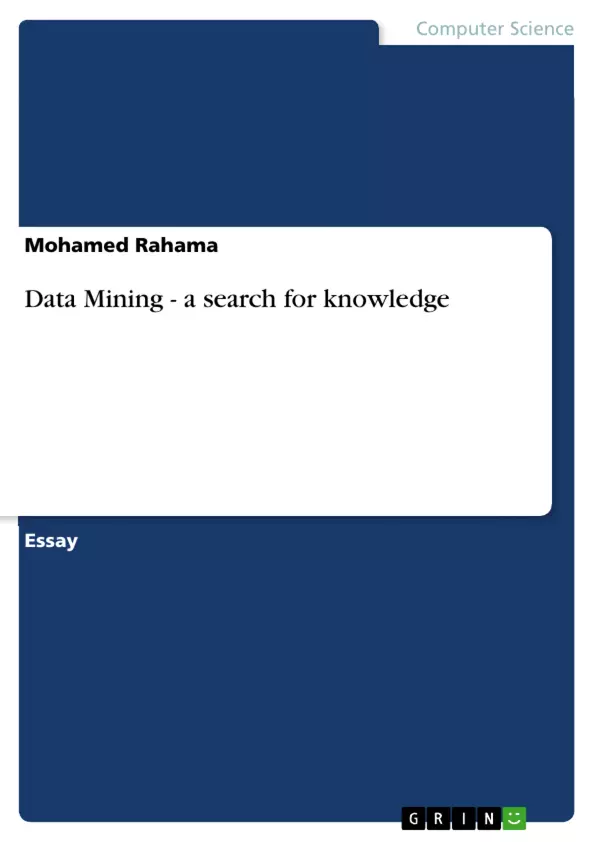Data mining is an independent science that based on advanced ways for information retrieval. Data mining is dealing with knowledge discovery in data warehouses without predefined hypotheses. So it is quite different from other applications such as decision support systems, OLAP and others which are looking for information on the factors and assumptions that we know it in advance. Data Mining supports multiple algorithms which have the ability to adopt automatic classification of historical data and predict future events.
Data mining in the databases is designed to extract the hidden information, and it is a modern technology that imposed itself strongly in the information revolution, in the light of the great technological development and widespread use of data warehouses. Data mining techniques focus on building future forecasts and explore the behavior and trends, allowing a good estimation for right decisions that taken in a timely manner.
This paper provides a general definition of data mining science and its most important techniques and algorithms used.
Inhaltsverzeichnis (Table of Contents)
- Introduction
- Data mining main objectives
- Data mining concept
- Why data mining?
- The process of knowledge discovery
- Data Preprocessing
- Data mining methods
- Data mining algorithms and models
- Data mining: a practical case study
- Mining the web
- Advantages and disadvantages of data mining
- Data Mining future
- Conclusion
Zielsetzung und Themenschwerpunkte (Objectives and Key Themes)
This paper aims to explore the concept of data mining, its principles, and algorithms for knowledge discovery. It focuses on the process of knowledge discovery in databases, encompassing data preprocessing techniques, data mining methods, and the application of data mining techniques and models like classifications, clustering, associations, description, estimation, prediction, and sampling. The paper also discusses the advantages and disadvantages of data mining and explores its future potential.
- The concept and importance of data mining
- The process of knowledge discovery in databases
- Data mining techniques and models
- Applications and practical case studies of data mining
- Advantages, disadvantages, and future of data mining
Zusammenfassung der Kapitel (Chapter Summaries)
- Introduction: This chapter introduces the concept of data mining as a tool for extracting valuable information and knowledge from large datasets. It highlights the increasing need for effective data analysis techniques due to the massive growth in data storage and retrieval. The chapter also explores the historical context of data mining and its development as a response to the challenges posed by large databases and data warehouses.
- Data mining main objectives: This chapter outlines the primary goals and objectives of data mining. These objectives include explaining observed phenomena, verifying existing theories, and discovering new and unexpected relationships within data. The chapter provides examples to illustrate these objectives, highlighting the potential applications of data mining in various fields.
- Data mining concept: This chapter delves deeper into the definition and concept of data mining, emphasizing its role in knowledge discovery from large datasets. The chapter discusses the process of searching and analyzing huge databases to extract patterns, relationships, and correlations between data elements. It also touches upon the interdisciplinary nature of data mining, highlighting its connections to fields like artificial intelligence, statistics, machine learning, and databases.
- Why mining data?: This chapter explores the reasons behind the increasing importance of data mining in today's data-driven world. The chapter uses the example of supermarket transactions to illustrate how large amounts of data can be accumulated and how data mining can be utilized to extract valuable insights from this data. It emphasizes the ability of data mining to discover hidden patterns, predict future trends, and support decision-making in various business and research contexts.
- The process of knowledge discovery: This chapter delves into the detailed process of knowledge discovery in databases, outlining the seven stages involved. These stages include data cleaning, data integration, data selection, data transformation, data mining, pattern evaluation, and knowledge presentation. The chapter explains the purpose and significance of each stage and provides a general overview of the architecture of a data mining system.
Schlüsselwörter (Keywords)
The main keywords and focus topics of this text are data mining, knowledge discovery, data preprocessing, data mining techniques, data mining models, data mining applications, and the future of data mining. This work explores the concepts and principles of data mining, highlighting the role of this technology in extracting valuable insights from large datasets and supporting informed decision-making.
- Quote paper
- Mohamed Rahama (Author), 2012, Data Mining - a search for knowledge, Munich, GRIN Verlag, https://www.grin.com/document/201604



